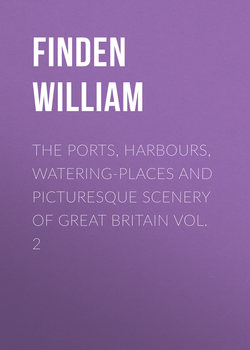Читать книгу The Ports, Harbours, Watering-places and Picturesque Scenery of Great Britain Vol. 2 - Finden William - Страница 9
THE MENAI BRIDGE
ОглавлениеThe Menai Bridge, one of the many triumphs of modern engineering, arose from the following circumstances. During the summer of 1818, Mr. Telford, the engineer, was engaged on a survey of the extensive line of road from the metropolis to Holyhead – that point of the Welsh coast nearest to Ireland, and situated in the Island of Anglesea. Between this island and the Caernarvon coast flows that arm of the sea familiar to every reader as the Menai Straits, through which the tide rushes with great velocity, owing to local peculiarities well known to all who have navigated that portion of the Channel. There were at this time five or six ferries across the strait; but these, owing to the circumstances mentioned, were generally difficult, and seldom without danger; so that the intercourse between the opposite shores being much impeded, was a source of daily inconvenience to the inhabitants. This was more particularly felt from the fact that one of the staple productions of Anglesea was its cattle, which, when sold for the inland counties or the London market, had to be driven into the water, and compelled to cross the strait by swimming, which was attended with risk of property as well as inconvenience. These circumstances were brought before the eyes of Telford, and his ever-active and ingenious mind set instantly to work, in order to remedy the evil by providing new facilities of intercourse. The result of his reflections and mature calculations on this engrossing topic was the possibility of throwing a bridge across the Menai.
The grand obstacle was a deep rapid tide-stream with high banks. To have erected a bridge of the usual materials would have obstructed the navigation; and any attempt to erect piers in the shifting bed of the sea must have inevitably proved a failure. Telford therefore recommended the erection of a suspension-bridge; and the plan, after due consideration, being approved by government, the work was commenced in 1820, carried on with great spirit, and in 1826 brought to a most successful termination. It is partly of stone, partly of iron, and consists of seven stone arches. These arches connect the land with the two main piers, which rise on an elevation of fifty-three feet above the level of the road, over the top of which the chains are suspended, each of which measures from its fastenings in the rock, one thousand seven hundred and fourteen feet. The topmasts of the first three-masted vessel which passed under the bridge were nearly as high as those of a frigate, but they cleared twelve feet and a half below the level of the roadway. The suspending power of the chains is calculated at two thousand and sixteen tons; and the total weight of each chain is one hundred and twenty-one tons.
Since the day it was first opened, the Menai Bridge has been the wonder of every traveller, an object of pilgrimage for scientific men of all countries, and a source of daily advantage to the United Kingdom, which no other work would have supplied. "The visiting of the Menai Bridge," says Mr. Smith, in his Guide to Snowdonia, "forms a new era in the lives of those who have not had that pleasure, and is a renewed luxury to those who have. There is something to be admired at every step: the effect of a passing carriage; the vibration caused by the mere application of the hand to the suspending-rods; the depth of a hundred feet to the level of the water; the fine view of the Straits in both directions; the lofty pillar erected in honour of Lord Anglesey; the diminutive appearance of persons on the shore; the excellence and strength of the workmanship, the beauty of the arches over the road through the suspension-piers, and the echo in them, all conspire to fascinate and detain the spectator. There is so much elegance, beauty, and magnificence, in this grand work of art, that it harmonizes and accords perfectly with the natural scenery around; and although in itself an object of admiration, still, in connexion with the features of the landscape, it heightens the effect of the general view."
"Seen, as I approached it," says Mr. Roscoe, "in the clear light of an autumnal sunset, which threw a splendour over the wide range of hills beyond, and the sweep of richly variegated groves and plantations which covered their base; the bright river, the rocky picturesque foreground; villas, spires, and towers here and there enlivening the prospect – the Menai Bridge appeared more like the work of some great magician than the mere result of man's skill and industry." Such were the encomiums lavished upon the first bridge which crossed the Menai; but men have since learned to view this structure with diminished admiration. Telford's great work no longer stands alone. The tubular bridge of his great successor, Stephenson, has taken its place beside the older and lighter work, and the very fact of its existence tends to diminish the wonder with which the first was looked upon.
